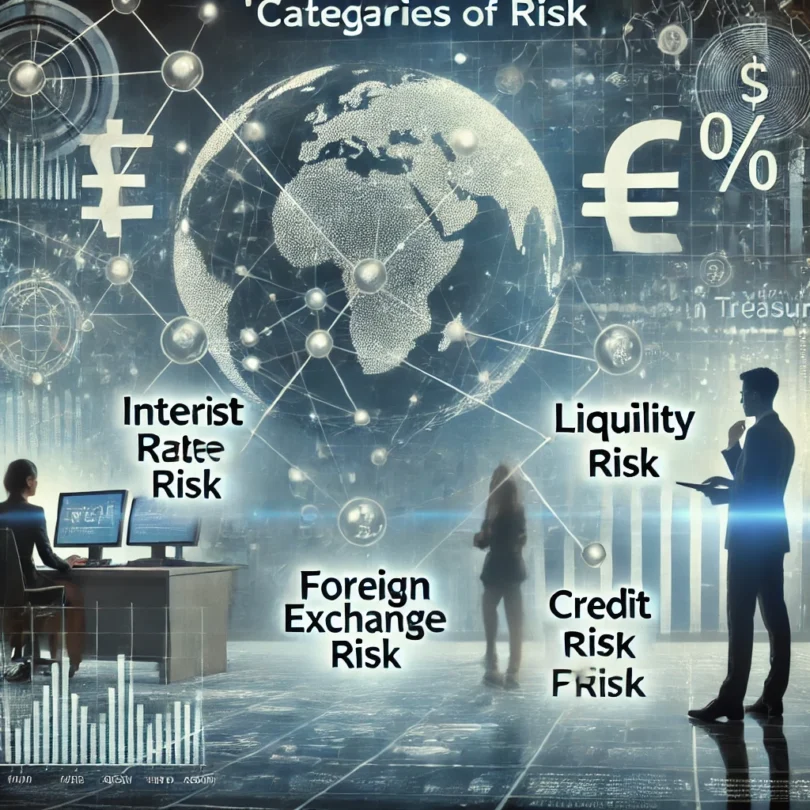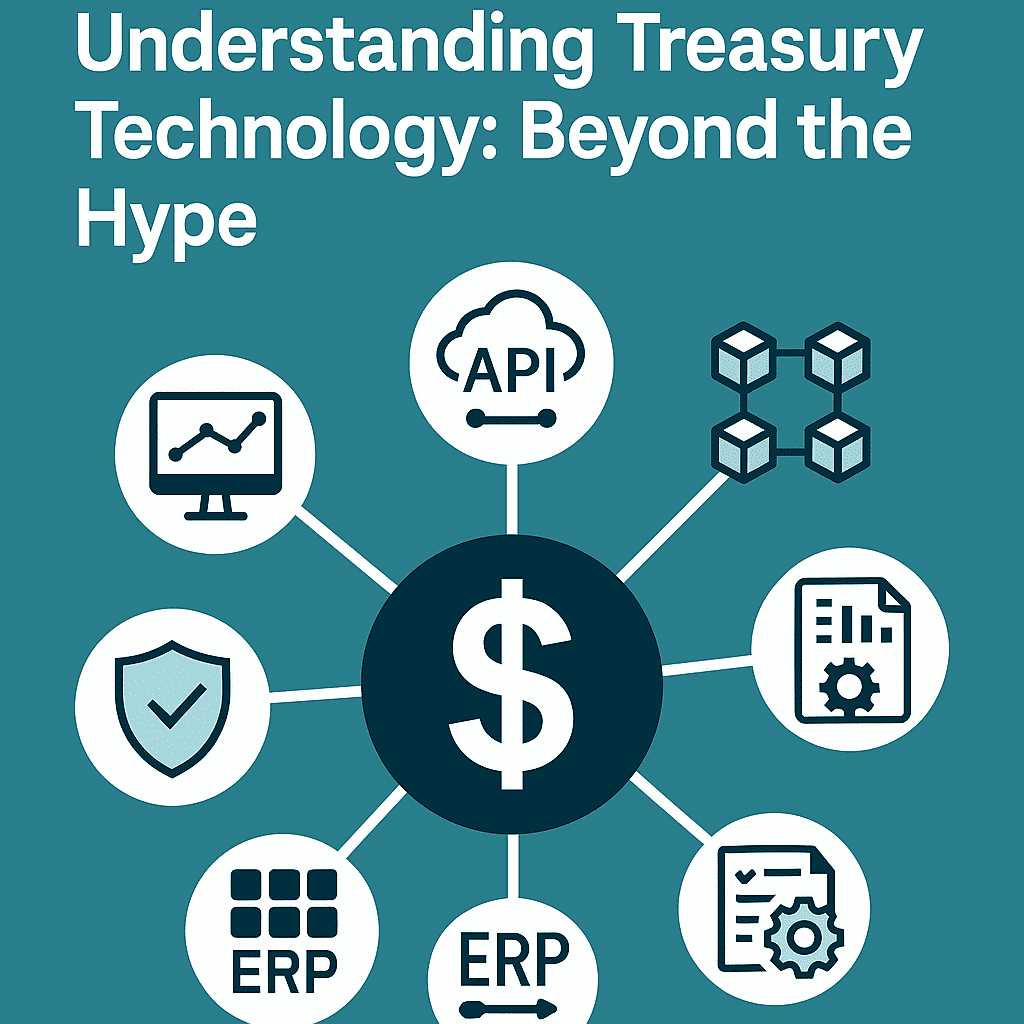Risk management is central to treasury operations, where various risks can threaten financial stability, operational efficiency, or strategic goals. Understanding the categories of risk is essential for identifying exposures, implementing mitigation strategies, and ensuring organizational resilience. This chapter explores the different categories of risks encountered in treasury, their sources, and strategies for managing them effectively.
- Categories of Risk
Treasury risks can be broadly categorized into financial risks, operational risks, strategic risks, and compliance risks. Each category encompasses specific types of risks that treasury teams must address.
- Financial Risks
2.1 Market Risk
- Definition: Risk arising from fluctuations in financial market variables.
- Types of Market Risk:
- Foreign Exchange (FX) Risk:
- Source: Volatility in currency exchange rates.
- Impact: Affects international transactions, asset valuations, and profitability.
- Example: A U.S. company with Euro-denominated receivables faces a drop in the Euro’s value.
- Mitigation: Forward contracts, FX options, or natural hedging by matching currency inflows and outflows.
- Interest Rate Risk:
- Source: Variability in interest rates impacting debt and investment returns.
- Impact: Increases borrowing costs or reduces yields on fixed-income investments.
- Example: A company with floating-rate loans sees higher interest expenses when rates rise.
- Mitigation: Interest rate swaps, caps, and floors.
- Commodity Price Risk:
- Source: Changes in the prices of raw materials, energy, or other commodities.
- Impact: Affects input costs and margins for manufacturing or energy companies.
- Example: A steel manufacturer faces rising iron ore prices.
- Mitigation: Futures contracts, supply agreements, or strategic sourcing.
- Foreign Exchange (FX) Risk:
2.2 Liquidity Risk
- Definition: Risk of insufficient cash to meet financial obligations.
- Types:
- Operational Liquidity Risk:
- Inability to cover short-term obligations, such as payroll or vendor payments.
- Funding Liquidity Risk:
- Inability to secure external financing when needed.
- Operational Liquidity Risk:
- Mitigation:
-
- Cash flow forecasting, maintaining credit lines, and optimizing cash pooling.
2.3 Credit Risk
- Definition: Risk of counterparty default on financial obligations.
- Sources:
- Customer non-payment.
- Default by a financial institution or trading partner.
- Mitigation:
- Credit checks, diversification, credit insurance, and collateral agreements.
2.4 Capital Structure Risk
- Definition: Risk of an imbalance between debt and equity financing, affecting cost of capital.
- Mitigation:
- Regularly reviewing debt-to-equity ratios and maintaining a balanced capital structure.
- Operational Risks
3.1 Process Risks
- Definition: Risks arising from inefficient or flawed treasury processes.
- Examples:
- Errors in payment processing.
- Mismanagement of cash pooling or forecasting.
- Mitigation:
- Automating repetitive tasks and implementing standardized workflows.
3.2 Technology Risks
- Definition: Risks from system failures, integration issues, or cyberattacks.
- Examples:
- A TMS outage delaying payment processing.
- Cybersecurity breaches exposing sensitive financial data.
- Mitigation:
- Regular system updates, multi-factor authentication, and robust cybersecurity measures.
3.3 Human Error Risks
- Definition: Errors or omissions by employees in treasury operations.
- Examples:
- Entering incorrect transaction details.
- Failing to hedge exposures in a timely manner.
- Mitigation:
- Training programs, approval hierarchies, and error-detection systems.
- Compliance and Regulatory Risks
4.1 Regulatory Risk
- Definition: Risk of non-compliance with financial laws, regulations, or reporting standards.
- Examples:
- Non-compliance with Basel III liquidity ratios.
- Failing to meet anti-money laundering (AML) requirements.
- Mitigation:
- Automating compliance reporting and conducting regular audits.
4.2 Legal Risk
- Definition: Risk of financial loss from lawsuits or contract disputes.
- Examples:
- Breach of financial covenants in loan agreements.
- Disputes over hedging contracts.
- Mitigation:
- Legal review of contracts and maintaining comprehensive documentation.
4.3 Reputational Risk
- Definition: Damage to the organization’s reputation due to financial mismanagement or non-compliance.
- Examples:
- Negative publicity from delayed supplier payments.
- Scandals involving fraud or unethical practices.
- Mitigation:
- Transparent reporting, ethical governance, and proactive public relations.
- Strategic Risks
5.1 Competitive Risk
- Definition: Risk of losing market share due to ineffective treasury strategies.
- Examples:
- Competitors offering better financing terms to customers.
- Mitigation:
- Continuous benchmarking and innovation in treasury practices.
5.2 Business Model Risk
- Definition: Risk that the organization’s revenue model becomes unsustainable.
- Examples:
- Over-reliance on specific markets or customers.
- Mitigation:
- Diversifying revenue streams and regularly reassessing the business model.
5.3 ESG Risk
- Definition: Risks related to Environmental, Social, and Governance (ESG) factors.
- Examples:
- Investments in industries facing regulatory crackdowns for environmental concerns.
- Mitigation:
- Integrating ESG metrics into financial planning and reporting.
- Emerging Risks
6.1 Climate Change Risk
- Definition: Financial risks arising from climate-related events or policies.
- Examples:
- Disruptions in the supply chain due to extreme weather events.
- Costs associated with transitioning to sustainable practices.
- Mitigation:
- Scenario planning for climate-related disruptions and investments in green initiatives.
6.2 Geopolitical Risk
- Definition: Risks from political instability, trade restrictions, or sanctions.
- Examples:
- Currency volatility due to geopolitical tensions.
- Trade barriers impacting international operations.
- Mitigation:
- Diversifying markets and maintaining hedging strategies.
6.3 Technology Disruption Risk
- Definition: Risks from rapid technological advancements rendering current systems obsolete.
- Examples:
- Competitors adopting blockchain or AI faster.
- Mitigation:
- Continuous technology investments and partnerships with fintech firms.
- Tools for Managing Multiple Risk Categories
7.1 Treasury Management Systems (TMS)
- Centralized dashboards for monitoring liquidity, FX, and credit risks.
7.2 Data Analytics Platforms
- Predictive modeling for scenario analysis and risk forecasting.
7.3 Hedging Platforms
- Automate and track financial hedging strategies.
7.4 Risk Registers
- Document and prioritize risks for regular review.
Conclusion
Understanding the categories of risk is a foundational step in building an effective risk management framework. By categorizing risks into financial, operational, compliance, and strategic buckets, treasury teams can systematically identify, assess, and mitigate exposures. Leveraging advanced tools, structured processes, and proactive strategies ensures that treasury operations remain resilient in the face of evolving challenges. Subsequent chapters will delve deeper into specific risk management techniques and case studies for each risk category.








Leave a Comment
You must be logged in to post a comment.